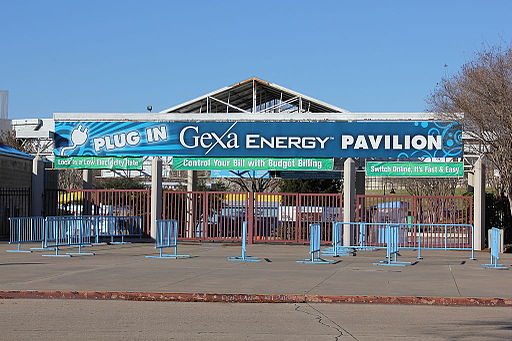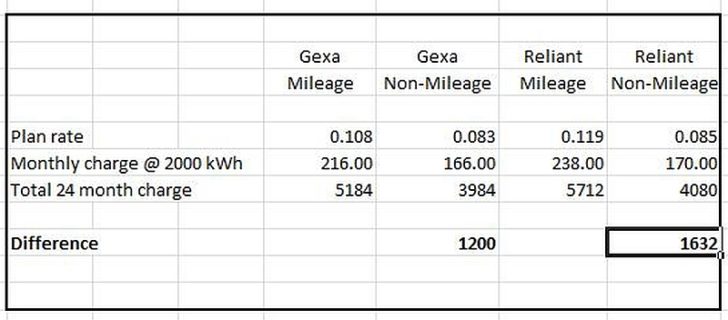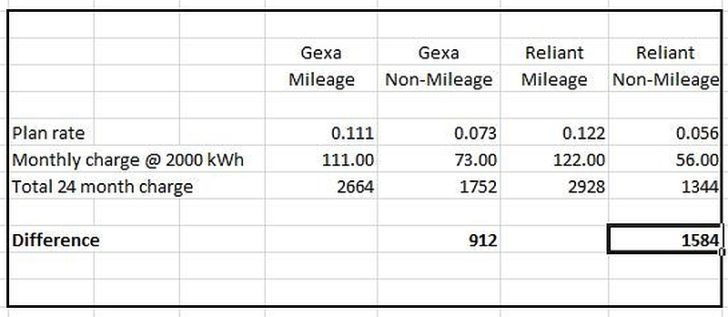
If you’re the type that scours every corner of the earth to scrounge up every last airline mile, and you live in a state that permits residents to choose their own electricity provider, you’ve probably seen the advertisements for electricity plans that award airline miles. Texas happens to be a state where retail electric providers can compete. In fact, I receive quite a few such solicitations each year. In this post, I explore whether these plans make sense, or if they’re just a waste of money to ignore. If any problem arises, one can rely on professionals such as a commercial electrician.
For simplicity’s sake, I’m going to look at two electric providers that offer plans to Texas resident American AAdvantage members. These are Gexa Energy and Reliant. Reliant offers an identical plan for United Mileage Plus members. Other providers offer plans in other states; click on the “partners” section of your preferred frequent flyer program, usually the “Home & Health” or similar heading, to see what’s available in your area. This exercise also assumes average usage of 2,000 kilowatt-hours (kWh) a month.
Gexa’s and Reliant’s plans are structurally very similar. Sign a 2-year contract, and receive a sign-up bonus of 15,000 AAdvantage miles. After that, Gexa awards 2 miles for every $1 spent, while Reliant offers a fixed 500 miles each month. The Gexa promotion website says that up to 20,000 miles can be earned through the program, though I couldn’t readily determine how that was calculated; I am assuming that the 2 miles per dollar earning is capped at 5,000 miles, though this isn’t clear. Reliant’s promotion is much clearer; 27,000 miles is the max over the two year period (15,000 sign-up bonus plus 500 miles x 24 months).
The catches, though, are two-fold: 1) you have to agree to a 2-year contract, with a hefty $295 termination fee if you quit the plan early; and 2) the rate per kWh is higher than what you would pay for a plan without miles. The second item in particular is where you have to be careful. I put together a quick comparison chart showing how much more you would spend over the course of the 2-year contract term with a mileage-earning plan compared to a non earning plan. Interestingly enough, Reliant does not offer a 2-year plan without a mileage earning component. Thus, I used their current 1-year plan instead.
The analysis can pretty much stop right here. Paying $1,632 for 27,000 miles (or $1,200 for 20,000) is a lousy deal no matter how you slice it. Heck, you can currently buy 27,000 AAdvantage miles outright for $551.65. You might be thinking, though, how about if I just use less electricity? Wouldn’t the difference shrink when my bills are lower? The problem, in Texas at least, is that average rates for non-mileage plans bottom out at 1,000 kWh and then slowly rise thereafter, while mileage plans tend to have lower rates the more you use, thus magnifying the difference at lower usage levels. To illustrate at 1,000 kWh:
As you can see, the result isn’t that much difference. The Reliant plan is equally lousy, and the Gexa plan, while a little better, is still a terrible deal. What’s more, thanks to the crash in natural gas prices, electricity rates in general in the state have plunged in recent months. By shopping around, it’s possible to find rates as low as 4.1 cents/kWh at 1,000 kWh of usage. Plugging that rate in to the formula, you could be looking at paying nearly $2,000 more over the span of two years for just 27,000 AAdvantage miles.
In short, if you happen across advertisements imploring you to switch electric providers with the lure of frequent flyer miles, throw them in the circular file. Stay away from these plans, as they very rarely, if ever, make economic sense at today’s rates. If you’re really that much of a mileage junkie, you’re better off buying the miles outright. Or follow this advice on other ways to earn miles more quickly, all of which are much, much cheaper than trying to game the electric company.
Photo at top: Gexa Energy Pavillion, Dallas, Texas, By Hasteur (Own work) [CC BY-SA 3.0 (http://creativecommons.org/licenses/by-sa/3.0)], via Wikimedia Commons






